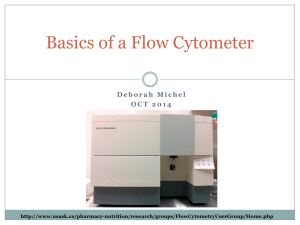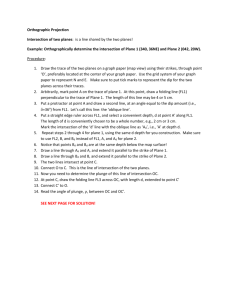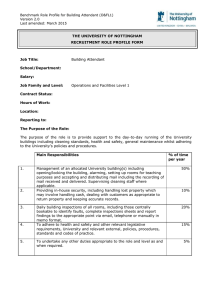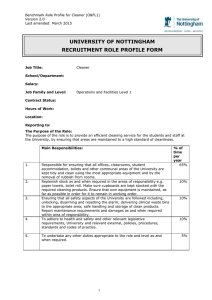Document 15566870
advertisement
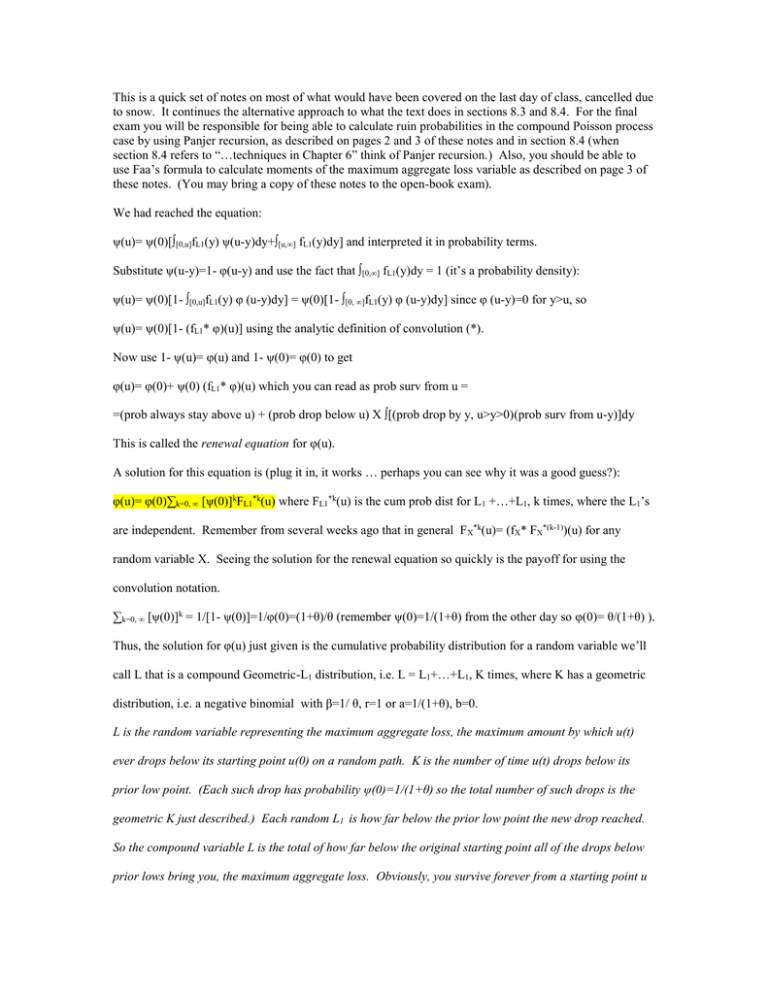
This is a quick set of notes on most of what would have been covered on the last day of class, cancelled due
to snow. It continues the alternative approach to what the text does in sections 8.3 and 8.4. For the final
exam you will be responsible for being able to calculate ruin probabilities in the compound Poisson process
case by using Panjer recursion, as described on pages 2 and 3 of these notes and in section 8.4 (when
section 8.4 refers to “…techniques in Chapter 6” think of Panjer recursion.) Also, you should be able to
use Faa’s formula to calculate moments of the maximum aggregate loss variable as described on page 3 of
these notes. (You may bring a copy of these notes to the open-book exam).
We had reached the equation:
ψ(u)= ψ(0)[∫[0,u]fL1(y) ψ(u-y)dy+∫[u,∞] fL1(y)dy] and interpreted it in probability terms.
Substitute ψ(u-y)=1- φ(u-y) and use the fact that ∫[0,∞] fL1(y)dy = 1 (it’s a probability density):
ψ(u)= ψ(0)[1- ∫[0,u]fL1(y) φ (u-y)dy] = ψ(0)[1- ∫[0, ∞]fL1(y) φ (u-y)dy] since φ (u-y)=0 for y>u, so
ψ(u)= ψ(0)[1- (fL1* φ)(u)] using the analytic definition of convolution (*).
Now use 1- ψ(u)= φ(u) and 1- ψ(0)= φ(0) to get
φ(u)= φ(0)+ ψ(0) (fL1* φ)(u) which you can read as prob surv from u =
=(prob always stay above u) + (prob drop below u) X ∫[(prob drop by y, u>y>0)(prob surv from u-y)]dy
This is called the renewal equation for φ(u).
A solution for this equation is (plug it in, it works … perhaps you can see why it was a good guess?):
φ(u)= φ(0)∑k=0, ∞ [ψ(0)]kFL1*k(u) where FL1*k(u) is the cum prob dist for L1 +…+L1, k times, where the L1’s
are independent. Remember from several weeks ago that in general F X*k(u)= (fX* FX*(k-1))(u) for any
random variable X. Seeing the solution for the renewal equation so quickly is the payoff for using the
convolution notation.
∑k=0, ∞ [ψ(0)]k = 1/[1- ψ(0)]=1/φ(0)=(1+θ)/θ (remember ψ(0)=1/(1+θ) from the other day so φ(0)= θ/(1+θ) ).
Thus, the solution for φ(u) just given is the cumulative probability distribution for a random variable we’ll
call L that is a compound Geometric-L1 distribution, i.e. L = L1+…+L1, K times, where K has a geometric
distribution, i.e. a negative binomial with β=1/ θ, r=1 or a=1/(1+θ), b=0.
L is the random variable representing the maximum aggregate loss, the maximum amount by which u(t)
ever drops below its starting point u(0) on a random path. K is the number of time u(t) drops below its
prior low point. (Each such drop has probability ψ(0)=1/(1+θ) so the total number of such drops is the
geometric K just described.) Each random L1 is how far below the prior low point the new drop reached.
So the compound variable L is the total of how far below the original starting point all of the drops below
prior lows bring you, the maximum aggregate loss. Obviously, you survive forever from a starting point u
only if L≤u, so it makes sense that φ(u)= the cumulative probability distribution for L, the compound
Geometric-L1 as just described.
This formula for φ(u) gives us a lot of alternatives to learn about probabilities of survival φ(u) or of ruin
ψ(u)=1- φ(u)=SL(u).
I.
We can use Panjer recursion to calculate numerical values for φ(u) (and ψ(u)),
II.
We can use Faa’s formula and our knowledge about moments of L 1 from previous class to
determine the moments of the maximum aggregate loss variable L.
III.
If the single loss variable X has nice properties we can write down an exact analytic formula
for ψ(u), for example if X is an exponential or a gamma random variable.
I. Panjer Recursion
To use Panjer recursion on the formula for φ(u) we need to discretize the distribution for L1. Remember
that fL1(y)=SX(y)/μX so discretizing L1 just means to pick up values of SX(y) at points half-way between
your discrete values of y, i.e. SX(y+d/2)d/μX where d is the discrete interval.
(see Example of Compound Geometric and Panjer Recursion For Ruin Probabilities on the course
website. There is an issue of whether to use the true value of μ X and treat the approximation just as an
approximate fL1(y), or view the discrete values as coming from an approximation discretizing fX(y) itself, in
which case you have to pick up any change in μX (and later μ'X2) that result from the approximation. I
prefer the true value approach, which is “alternative #2” on the website example. It means that you need to
calculate each fL1(y) based on the surface interpretation. Subtract successive values of ∑z>ySX(z+d/2))d
from the true value of μX to get successive values of the approximation for SL1(y) μX, and then take
differences of the resulting SL1(y) values to get fL1(y) values.)
The Panjer recursion formula here will be:
fL(u)=[1/(1-afL1(0))] ∑y=1,u(a+b(y/u))fL1(y)fL(u-y) where a=1/(1+θ), b=0, fL1(y)=SX(y+d/2)d/μX (by
whichever of the two methods discussed above that you choose), and the starting value is
fL(0)=PK[fL1(0)]=[1-(1/θ){fL1(0)-1}]^(-1). You can just go ahead and program your spreadsheet with this
and get values for fL(u) which will sum to values for FL(u)=φ(u) and then ψ(u)=1- φ(u) gives you the
ruin probabilities.
Although you don’t need it for the spreadsheet calculations, you can do a little algebra on the values just
given and get fL(u)=[1/{(1+θ) μX - SX(d/2))d}] ∑y=1,uSX(y+d/2))d fL(u-y), where once again you need to
choose which alternative you’ll use to come up with μX and SX(z+d/2))d in the approximation. This version
of the formula shows directly how the tail probabilities SX(y) of the original single loss variable X
compound themselves to determine the probability density fL(u) for the maximum aggregate loss to be u.
II. Moments of the Maximum Aggregate Loss Variable L
Since it is a compound Geometric-L1 variable, we can write down the moment generating and cumulant
generating functions for L:
ML(r) = PK(ML1(r)) = [1 – (1/θ){ML1(r)-1}]^(-1)
We can get raw moments of L by using Faa’s formula on this, remembering what we already know about
the raw moments of L1. Namely, μ'L1 k = (1/(k+1)) μ'X (k+1) / μX follows directly from surface interpretation
and fL1(y)=SX(y)/μX.
Taking logarithms, CL(r) = -ln[1 – (1/θ){ML1(r)-1}] so once again Faa’s formula and knowledge of the raw
moments of L1 will let us calculate cumulants of the aggregate loss variable L.
III. Exact Analytic Expressions for ψ(u)
ψ(u)=SL(u) where L is the compound Geometric-L1 as shown above.
If X happens to be exponential, then by the memory-less property L1 with fL1(y)=SX(y)/μX is also
exponential (with same mean). We showed some weeks ago that for a compound distribution L with
exponential secondary and primary denoted by K we could rewrite the decumulative distribution as
SL(x)=e-x/μ ∑j=0,∞[(x/μ)j / j!]SK(j) where in this case K is geometric with a=1/(1+θ) and μ is μX, the mean of
the exponential. Putting in this value for a, summing the geometric series that appears in SK(j), and doing
some algebra will give ψ(u)=SL(u)=(1/(1+θ))e-(θ/(1+θ)) u/ μ so the ruin probability is exactly a constant times
an exponential function of starting surplus, with the parameters shown.
A similar, but more complex analysis can be done starting from the result we had that
SS(x)=e-x/μ ∑j=0,∞[(x/μ)j / j!]SK([j/α]) for S a compound distribution with gamma secondary.

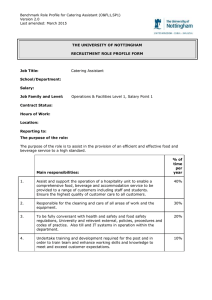
![I —i--i---— I(h ]\“IATH132O: Seciuences aic1 Series Part ho](http://s2.studylib.net/store/data/012118255_1-ff394e5e8d55a8b795249016e5bf5eb8-300x300.png)


